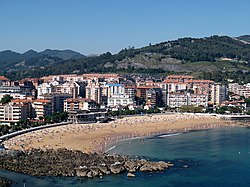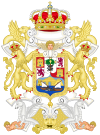Castro Urdiales
| Castro Urdiales | |||
|---|---|---|---|
| Municipality | |||

View of Castro Urdiales, Brazomar beach
|
|||
|
|||
 |
|||
| Location os Castro Urdiales in Spain | |||
| Coordinates: 43°23′4″N 3°12′54″W / 43.38444°N 3.21500°W | |||
| Country |
|
||
| Founded | Flaviobriga 74 AD | ||
| Government | |||
| • Alcalde | Angel Fernando Díaz-Munio Roviralta (2015) (Castroverde) | ||
| Area | |||
| • Total | 96.72 km2 (37.34 sq mi) | ||
| Elevation | 19 m (62 ft) | ||
| Population (2010) | |||
| • Total | 32,258 | ||
| • Density | 330/km2 (860/sq mi) | ||
| Demonym(s) | Castreños | ||
| Time zone | CET (UTC+1) | ||
| • Summer (DST) | CEST (UTC+2) | ||
| Postal code | 39700 | ||
| Website | Official website | ||
Castro Urdiales is a municipality of northern Spain, a seaport situated on the bay of Biscay. Castro Urdiales is a modern town, although its castle and the Gothic-style parish church of Santa María de la Asunción, date from the Middle Ages. Its chief industries are tourism, fishing, and the preservation of fish, especially sardines and anchovies, in oil. The "Lolin" and "La Castreña" anchovy canning factories serve as a reminder of the town's closeness to this industry and its proximity to the sea.
Tourism has greatly increased in Castro Urdiales in the last thirty years; many people from Bilbao and other parts of the Basque Country and Cantabria as well as Northern Spain in general keep summer homes in the town. Although the number of people registered in the town is around 32,000, the summer population can double or even triple this figure.The town is popular because of its beaches and scenic harbor.
Castro Urdiales was originally called Portus Amanum, and was the chief city of the Autrigones. In AD 74 a Roman colony was established under the name Flaviobriga, during the reign of emperor Vespasian. It was most likely established to mine the abundant iron in the area.
In 1163 the town of Castro Urdiales received its municipal charter. It lay at the western tip of the coastline of Navarre until 1200, when the kingdom was invaded by Alfonso VIII of Castile. Castro Urdiales benefited much from its location at a crossroads in the trade between northern Europe and Castile. It remained in Biscay until 1476 at least, but it is not cited in the seigneury's assemblies thereafter. Until the 18th century, the town recurrently attempted a reincorporation to Biscay (attested in 1799), but its attempts were met with the frontal refusal of Bilbao on account that it could tip the scale against its own trade balance.
...
Wikipedia



